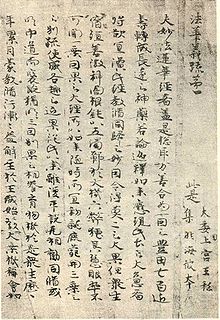Sutra
The Sanskrit word sutra (सूत्र: sūtra , “thread”, “chain”; Pali : sutta , sūtta ; translated “ discourse ”) denotes either a short doctrine in ancient and middle Indian literature that is memorable through its verse form or a collection such tenets. In addition to the sutra in Sanskrit literature, the sutra can also be found in the teaching texts of Buddhism and Jainism , but without the short, aphoristic character. The Pali word sutta corresponding to the sutra refers to certain parts of the Pali canon, which is only canonical for Theravada Buddhism .
Memorandum character
The oldest Indian texts were passed down orally and are much older than the use of writing. Despite excellent mnemonic methods, they were looking for ways to pass on complex issues in a condensed, memo-like form. This striving for brevity is responsible for the fact that today's content is often difficult to understand. However, the sutras were an effective reminder for the students of the time, who received detailed oral explanations at the same time.
In order to prevent the falsification of the text when it is passed on orally from generation to generation, a strict form of verse was used. A verse that a particular meter has and rhymes, can not just change; Irregularities caused by adding, changing or leaving out individual words are noticed immediately. In addition, the lyrics were sung to a melody or spoken in singsong. Disadvantages (a lack of redundancy , as indicated in the German word “ Dichtung ”) were apparently more than offset by advantages (memorability).
The sutra style found its most consistent expression in the school of grammarians, especially Panini , who presented a complete system of Sanskrit in a few pages. The grammarian Patanjali said that if a sutra author could save half a short syllable, he would be as happy as if a son were born to him.
Almost all philosophical systems (darshanas) of earlier times found their form in the form of sutras; Extensive commentary literature has also survived.
Hinduism
In Hinduism, short excerpts from the Vedas are called sutras. A definition for Sutra is given in Skanda - Purana : “A Sutra is an aphorism that expresses the essence of all knowledge in a few words. It must be universally applicable and flawless in its linguistic presentation. "
The well-known Brahma Sutra (also called Vedanta Sutra) is ascribed to Vedavyasa . Vedanta means "end" or "completion of the Veda". The main purpose of the sutra and discussions in the Upanishads is to bring out the personal aspect of the Absolute Truth. The Vedanta Sutra summarizes the philosophical insights of the Upanishads. The sutras of Patanjali form the basis of Raja Yoga .
One who pulls the strings: In the ancient Indian doctrine of music and dance Gandharva , as summarized by Bharata in his work Natyashastra at the turn of the century , the Sutradhara is the master of ceremonies of the ritual theater, who greets the audience in the prelude ( Purvaranga ) and later the scenes explained. Such a theater director is characteristic of many Indian forms of theater to this day.
Buddhism

The Buddhist doctrine was passed on orally and only recorded much later, discourses of the Buddha , which is why the introduction to all sutras is: "So I heard it" (pali: evam me suttam). There were specialists for the recitation of certain texts, so-called Bhāṇaka. In these discourses, which always revolve around a specific topic, the Buddha often addresses a group of monks . A situational start is characteristic: “That's how I heard it: At one time the sublime was staying in the wildlife park of Isipatana near Varanasi . There the Blessed One turned to the five monks and spoke ... "
There are three large canon collections: the Pali canon with its “basket of discourses” ( Suttapitaka ), the Chinese Sanzang (standardized today in the Taishō Tripitaka) and the Tibetan Kangyur (Kanjur). The sutras are often available in different forms in the various collections of texts; this is due to interpretations of the various Buddhist schools ( Theravada , Mahāyāna , Vajrayāna ).
The Mahāyāna-Sutras have their own style, which thematically go beyond the liberation paths described in the Pali canon. Some of these works are of central importance for certain schools and directions of Mahāyāna, such as the Lotos Sutra for the schools of Nichiren Buddhism or the Great Sukhāvatī Sutra for the schools of the Pure Land .
Understanding and research
In the literal sense, Sutra means “thread” or “chain”, often mistakenly interpreted as “guide”. This interpretation is obvious, because in Sanskrit practically all “guidelines” have the word Sutra in the title, for example the Yoga Sutra of Patanjali or the Kamasutra of Vatsyayana, which is better known in German-speaking countries . In contrast to the Ślokas, the Sūtras are prose texts, which are kept extremely concise in order to make learning easier.
The first Vedic sutras were written in Prakrit , a Middle Indian language form and therefore a vernacular further development of Sanskrit . The pioneer of Prakrit research was the German professor Richard Pischel in the second half of the 19th century . As part of his research at the University of Halle , the first modern systematic grammar of Prakrit was written; numerous Vedic sutras have now been translated and published in dissertations, including the Karmapradipa by Friedrich Schrader (1889) and Baron Alexander von Staël-Holstein (1900).
See also
Web links
Individual evidence
- ↑ Johannes Bronkhorst: Sūtras In: Knut A. Jacobsen et al. (Ed.): Brill's Encyclopedia of Hinduism Online, January 30, 2019
- ↑ Sutradhara, Indian Theater Character. Indian Net Zone
- ^ Bechert, H. & von Simson, G. (1993). Introduction to Indology. Darmstadt: Scientific Book Society, p. 55